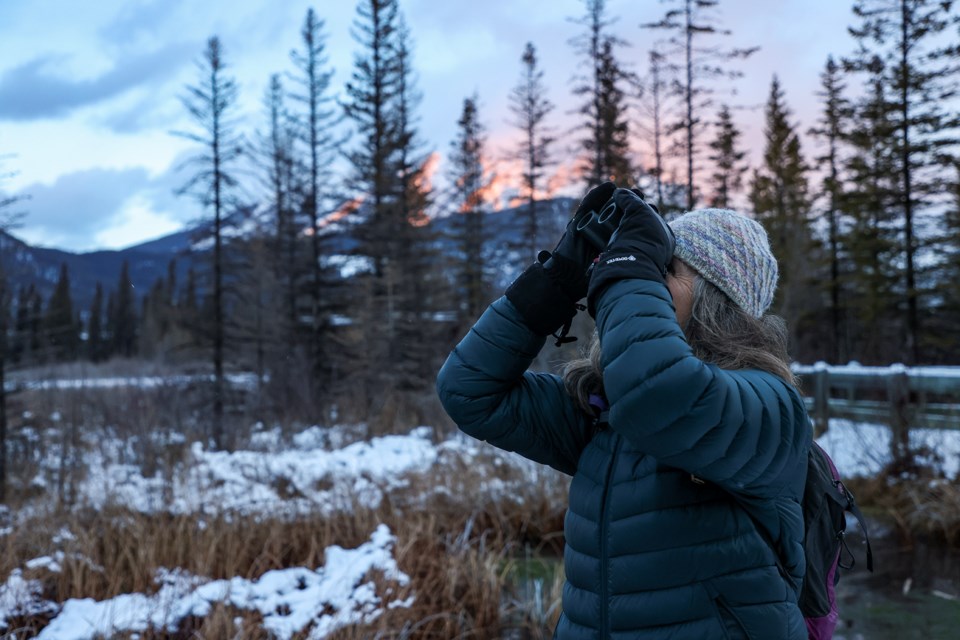BOW VALLEY – With their binoculars set to the sky, trees and water, Bow Valley bird watchers count and identify all they see for the annual Christmas Bird Count.
The Banff-Canmore bird count, organized by the Bow Valley Naturalists, occurred Dec. 16 where more than 80 twitchers spotted around 2,200 individual birds across 44 species.
What was originally a Christmas bird hunt turned into a new holiday tradition on Christmas day in 1900 after an ornithologist and early member of the Audubon Society, Frank M. Chapman, proposed the idea of counting birds rather than hunting them.
“I fell in love with birds and birding at a very young age and Christmas Bird Counts are one of the easiest and best ways for the general public to get involved and take a look into the birding world,” said Ethan Denton, Christmas Bird Count organizer.
“I think my favourite part is probably just the community. It's an incredible opportunity to meet all sorts of new people and bond over a common interest and enjoy the outdoors at a time when a lot of people aren't getting outdoors as much.”
Heather Dempsey, long-time Christmas Bird Count organizer, said some of this year’s highlights from the group was two western grebes, two bald eagles and a northern goshawk. She also said having the potluck afterwards to share stories of day was a highlight for her.
“You celebrate any bird you see,” said Dempsey. “One lucky group even saw a wolf in the distance. So that was pretty nifty.”
To conduct the various counts across the Western Hemisphere, each count monitors a circle with a 24-kilometre area where bird watchers spread out tallying all they observe. In 2022, the Audubon Society reported there were 2,625 Christmas counts across Canada, the United States, Latin America, the Caribbean and Pacific Islands. The counts are made between Dec. 14 to Jan. 5.
“The Canmore count is a good one because it's been running for so long. So, we do have a good buildup of data,” said Denton. “Also, because we have a very unique habitat here. We're really lucky to be able to count in the mountains.”
In the Bow Valley the circle is centred on the Bow River below Mount Rundle and spans west of Vermilion Lakes and east into Canmore. Dempsey organizes the Banff side and Denton organizes the Canmore area.
“You just go along a trail or there's some areas that are more remote so you are bushwhacking through the bushes going down to, say, the Bow River or something, and even in our towns we walked the streets through the alleys looking for habitat where you might find birds,” said Dempsey.
Along with exploring trails and water bodies, people may also count birds with the aid of feeders, but a federal legislation introduced in 2020 prohibited birdfeeders in Banff National Park, so they stick to counting birds by surveying the park on foot. In Canmore, bird feeders are allowed between Dec. 10 to March 31.
“We just said in Banff we will not have people who are stationed looking at their feeders all day like we have [before] because that's encouraging feeding wildlife,” said Dempsey.
Last year in the valley, 82 bird watchers observed 2,090 individual birds across 44 different species. Since the count began in the Bow Valley in 1975, more than 132,000 individual birds have been recorded.
“What I found over the years, no matter what I see is that it’s just a great day to be out there tuning into what's around you because you see not only birds or not birds, you may not be lucky, but you'll see signs of other wildlife,” said Dempsey.
Audubon Society reported in 2022 there were 40,298,635 individual birds tallied from the Arctic to South America.
The Christmas Bird Count is the longest-running citizen science project in North America and its data is used for population trends and research of various means as the database is public on www.birdscanada.org and www.audubon.org.
“Why it's become important is because this is the longest and probably the most full recording of wildlife information that we have, at least in North America… the coverage is quite amazing. And the fact that it's all citizen science driven. It's all volunteers that do this,” said Dempsey.
The Bow Valley Naturalists will be hosting the next count Dec. 14, 2024.




